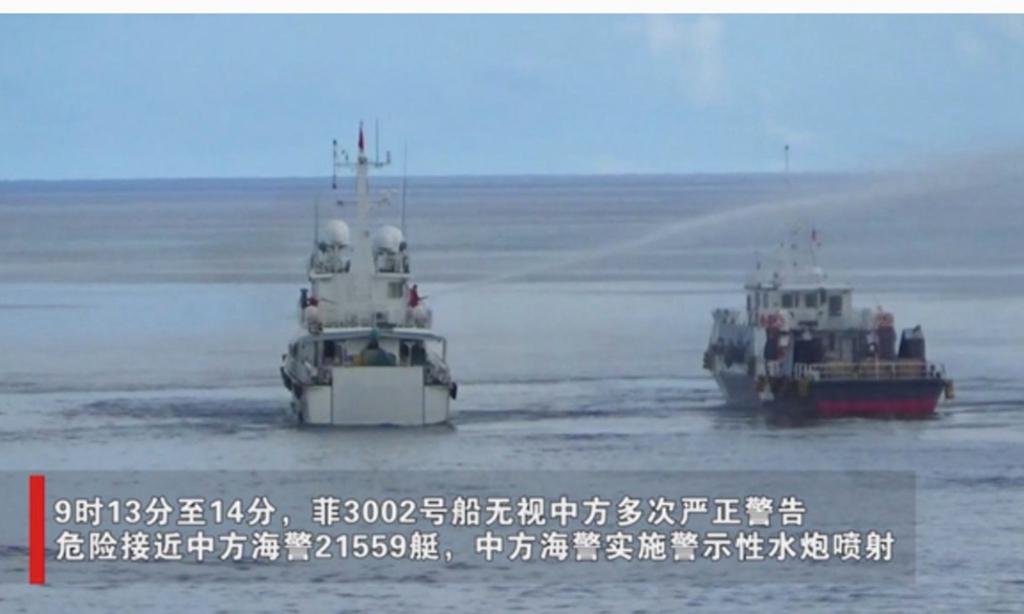CCG employs water cannon warning at Tiexian Jiao for 1st time in response to escalated Philippine provocation: on-site video shows

A screenshot from the video released by CCG at night on May 22, 2025
A briefing by the China Coast Guard (CCG) said on Thursday that Philippine government vessels 3002 and 3003 illegally intruded into the waters near Zhubi Jiao and Tiexian Jiao of China's Nansha Qundao on Wednesday without permission from the Chinese government. The Philippine side also organized personnel to illegally land on Tiexian Jiao and carry out activities there. In response, CCG law enforcement personnel carried out control measures in accordance with the law and conducted on-reef inspection and evidence collection of illegal activity.
The relevant video evidence released by the CCG at night on Thursday showed that in dealing with the Philippine infringement, the CCG vessel adopted the method of water-cannon warning, and dispatched high-speed boats to chase and intercept the Philippine vessels. The CCG personnel also boarded the reef to collect evidence and displayed the Chinese national flag to assert sovereignty.
This time, the Philippines simultaneously dispatched two vessels to participate in infringement activities near Zhubi Jiao and Tiexian Jiao, and approached the Chinese vessel in a dangerous manner. In response to the provocative actions of the Philippine 3002 vessel, the CCG vessel 21559 carried out a warning water cannon spray. The Global Times learned that this is the first time that the CCG has taken the countermeasure of water-cannon warning against the Philippine infringing vessel in waters near Tiexian Jiao.
The video evidence showed that during the water-cannon warning against the Philippine vessel 3002, the CCG vessel 21559 mainly aimed at the main mast device of the vessel 3002.
Yang Xiao, an international strategic scholar, told the Global Times that the main mast of the Philippine vessel was mainly equipped with some electronic devices. This approach can effectively prevent the infringement behavior of the Philippine vessel, and at the same time, minimize the additional harm to the Philippine personnel. This response shows that the control measures taken by the CCG against the Philippine vessels in accordance with the law are reasonable and moderate.
The CCG stated in the briefing that from 9:13 to 9:14 on May 21, the Philippine vessel 3002 ignored the repeated solemn warnings from the Chinese side and approached the CCG vessel 21559, which was conducting normal law enforcement missions, in a dangerous manner, resulting in a collision. This shows that the responsibility lies entirely in the Philippine side. The released video exposed more details - the Philippine vessel suddenly adjusted its course to the left and deliberately collided with the CCG vessel, but was forced to change its course under the firm obstruction of the CCG vessel.
Chen Xiangmiao, director of the World Navy Research Center at the National Institute for South China Sea Studies, told the Global Times that the Philippine official vessels 3002 and 3003 are from the Philippine Bureau of Fisheries and Aquatic Resources (BFAR). Their deliberate ramming behavior is not a civil act, but reflects the intention of the Philippine government to escalate the tension at Tiexian Jiao.
It is worth noting that although the Philippine vessels 3002 and 3003 are official vessels of the BFAR, the Philippines has previously packaged the activities of these two vessels as scientific research or fishery management activities, and the two vessels have always been the main force of the Philippines in participating in the infringement activities in the South China Sea.
The Global Times found out by sorting out the public reports that the Philippine vessels 3002 and 3003 had previously cooperated with the Philippine coast guard vessels to participate in the infringement activities in the South China Sea for many times, delivered supplies to the Philippine infringing fishermen, and had also intruded into the sea areas near China’s Huangyan Dao and Xianbin Jiao for many times, deliberately approaching in a dangerous manner and ramming the CCG vessels that were conducting normal law enforcement activities.
During the infringement action this time, the Philippine personnel also took a speedboat to illegally board Tiexian Jiao. The video showed that CCG personnel boarded the reef to collect evidence, and used professional detection equipment to inspect Tiexian Jiao. The on-site operation was professional, standardized, reasonable and legal.
"Facing the deliberate ramming at Tiexian Jiao by the small boat dispatched by the Philippines, the CCG dispatched small boats to intercept, which reflects that China’s control is effective but maintain restraint," said Chen. The expert stressed that China firmly safeguards the seriousness of the Declaration on the Conduct of Parties in the South China Sea and ensures that Tiexian Jiao remains in a state of being uninhabited and without facilities. However, it can be clearly seen from the video that the Philippines is violating this principle and ignoring the previously reached consensus.
China has indisputable sovereignty over the Nansha Qundao and the surrounding waters. The actions of the Philippine side constitute a serious infringement on China's territorial sovereignty, violate the Declaration on the Conduct of Parties in the South China Sea, and undermine peace and stability in the region, the spokesperson of CCG Liu Dejun said on Thursday.
"We urge the Philippine side to immediately cease its infringing actions. The CCG will continue to carry out rights protection and law enforcement activities in waters under China's jurisdiction in accordance with the law," Liu said.